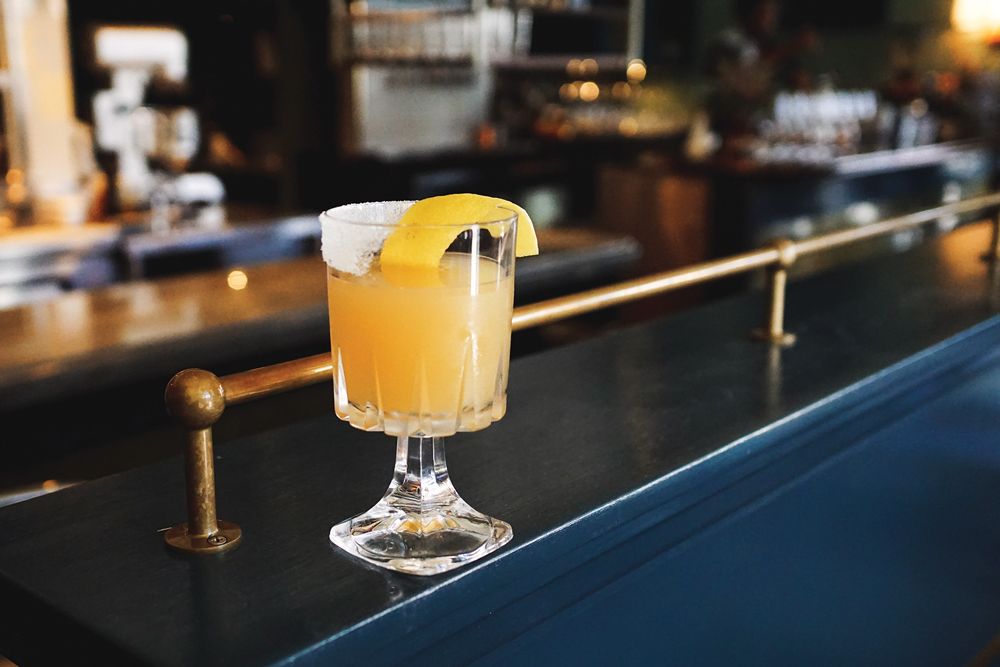At St. Lawrence, Cognac stars in elegant classic cocktails

Credit to Author: Mary Beth Roberts| Date: Sat, 12 Oct 2019 13:06:35 +0000
If you’re running the cosy little bar at a restaurant that specializes in classic French cuisine, there’s really only one direction to go with your cocktails, and wildly experimental isn’t it.
“The idea behind the bar program is to match the food from the kitchen,” says Yacine Sylla, bar manager of the multiple-award-winning St. Lawrence. “To go with the food, we have Cognac-based cocktails. We stick to classics. We like that boozy-forward drink. We have the Old Fashioned, the Vieux Carré, Sazerac, Cognac Manhattan, French 75 and a classic from New Orleans, the Almond Crusta.”
Sylla, who originally hails from Paris but has tended bar in Vancouver since 2008, has been part of the St. Lawrence team since chef-owner Jean-Christophe Poirier opened his homage to Quebecois heritage in 2017. Since then, St. Lawrence made No. 4 on the enRoute list of Canada’s Best New Restaurants, No 5. on Canada’s 100 Best, and was twice named Vancouver magazine’s Restaurant of the Year.
The raves tend to be for Poirier’s butter-rich cuisine, but the finely edited bar program deserves its fair share of the accolades.
For one thing, all the spirits Sylla uses are French, with the exception of a couple of Japanese whiskies in a nod to the restaurant’s location in historic Japantown. Mostly, that means the historic, double-distilled French brandy made in the region around the town of Cognac. In cocktails, that’s the affordable De Luze V.S. Cognac or the pricier Rémy Martin V.S.O.P.
(Because the early brandy trade in the 18th century was mainly with the British, aging grades are in English: V.S. or Very Special denotes a blend of brandies of which the youngest was aged at least two years in French oak casks; V.S.O.P. or Very Superior Old Pale, aged at least four years; XO or Extra Old, 10 years; and for even older, high-quality products, Hors d’âge or Beyond Age.)
At St. Lawrence, even cocktails typically made with whisky are made with Cognac, which adds a depth, elegance and rich, sweetly spiced, dried fruit character. Cognac may not have the hipster cred of, say, bourbon or mezcal, but what it does have is both flavour and legacy, as it was actually the original base for many classic cocktails until whisky became the more affordable and easily available alternative.
“Cognac goes with pretty much everything,” Sylla says. “It’s very smooth, with a nice finish. I find Cognac smoother than most whisky. It is just more refined.”
Cognac can be pricy—Rémy Martin’s iconic Louis XIII retails for $3,750 these days, and Hennessy’s Paradis Impérial for $3,850—so we’ve rounded up a few bottles in the relative-bargain $100 range.
Martell Blue Swift V.S.O.P.
Technically not a Cognac as the eaux-de-vie are finished in bourbon casks, the Blue Swift is rich, smooth and round, with notes of candied fruit, honey and sweet vanilla. $105
Hennessy V.S.O.P. Prestige
More than 60 eaux-de-vie combine in this well-known, well-balanced Cognac with flavours of vanilla, honeyed fruit, cinnamon, clove and crystalized ginger. $105
Rémy Martin V.S.O.P. Fine Champagne
A well-aged sipper from a legendary Cognac house. Powerful yet elegant, with thoughtful notes of dried figs, nuts, leather, spice and dark chocolate. $97
D’usse V.S.O.P.
Lighter than some V.S.O.P. Cognacs, yet still bold and complex, with notes of dried apricots, almonds, a hint of cinnamon and just a touch of butterscotch. $96
The Crusta was one of the first fancy cocktails, a trailblazer of a tipple, invented in 1850s New Orleans. Here, St. Lawrence bar manager Yacine Sylla puts his spin on a true classic.
Rim half the edge of a coupe glass with sugar. Combine all ingredients into a shaker with ice. Shake, then double-strain into the coupe. Garnish with lemon peel. Serves 1.